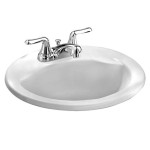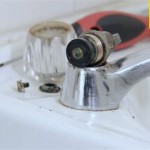I Have a Leak Under My Bathroom Sink: What To Do With It
Discovering a leak under a bathroom sink can be a source of immediate concern, potentially signaling a minor inconvenience or a more significant plumbing issue. Regardless of its apparent severity, a prompt and informed response is crucial to prevent water damage, mold growth, and escalating repair costs. Identifying the source of the leak, understanding the necessary safety precautions, and implementing appropriate troubleshooting steps are paramount to effectively addressing the problem. This article provides a comprehensive guide to handling a leak under a bathroom sink, covering essential actions and considerations for a successful resolution.
The initial reaction to finding a leak should involve a systematic assessment of the situation. Turn off the water supply to the sink to prevent further leakage and potential damage. Place a bucket or towels beneath the leak to contain any dripping water. This initial response minimizes the immediate impact of the leak and provides time to evaluate the problem thoroughly. Inspect the area carefully to determine the source and extent of the leak. This initial assessment is critical for determining the appropriate course of action.
Before attempting any repairs, safety should be the foremost consideration. Electricity and water present a hazardous combination. Ensure that any electrical outlets or appliances near the sink are dry and de-energized if there is any possibility of water contact. Wear appropriate protective gear such as gloves to avoid contact with potentially contaminated water or cleaning agents. These precautions minimize the risk of electrical shock or exposure to harmful substances during the repair process.
Identifying the Source of the Leak
Locating the precise source of the leak is crucial for effective repair. Common sources include the supply lines, drainpipe connections, faucet base, and the sink basin itself. A systematic inspection of each component is necessary to pinpoint the exact location of the water escape. Start by visually examining the supply lines connecting the shut-off valves to the faucet. Look for any signs of corrosion, cracks, or loose connections. These lines are often made of flexible braided stainless steel or copper and can degrade over time.
The drainpipe assembly, including the P-trap and tailpiece, is another common source of leaks. Check the connections between these components for tightness and signs of water damage. The P-trap, the curved section of the drainpipe, is designed to trap debris and prevent sewer gases from entering the bathroom. Over time, the connections to the P-trap can loosen or the trap itself can become damaged, leading to leaks.
The faucet base, where the faucet assembly connects to the sink basin, is also a potential leak source. Mineral deposits or corrosion can accumulate around the base, causing the seal to deteriorate. Check for any water pooling around the faucet base, and inspect the area for signs of water staining or discoloration. The faucet cartridge or O-rings within the faucet handle assembly can also fail, leading to leaks that may appear to originate from the base.
In some cases, the sink basin itself may be cracked or damaged, resulting in a leak. Inspect the basin carefully for any visible cracks, especially around the drain opening and faucet mounting holes. Hairline cracks may be difficult to see at first, but they can gradually worsen over time and lead to significant water leakage. Run water into the sink and observe the exterior for any signs of water seepage to help identify hidden cracks.
Troubleshooting Steps and Basic Repairs
Once the source of the leak is identified, various troubleshooting steps and basic repairs can be undertaken. For leaks originating from loose connections, tightening the fittings with a wrench may be sufficient. Ensure that the wrench is properly sized to avoid damaging the fitting. Avoid over-tightening, as this can strip the threads or crack the fitting, exacerbating the problem. After tightening the fitting, turn the water supply back on slowly and check for any remaining leaks.
If the leak is caused by a damaged or corroded supply line, replacing the line is often the best solution. Turn off the water supply to the sink and disconnect the old supply line. Measure the length of the old line and purchase a replacement of the same size and type. Ensure that the new supply line is compatible with the faucet and shut-off valve connections. Apply plumber's tape to the threaded connections before installing the new line to ensure a watertight seal.
Leaks in the drainpipe assembly can often be resolved by tightening the slip nuts that connect the various components. If the slip nuts are already tight, the rubber washers inside the connections may be worn or damaged. Purchase replacement washers of the correct size and type and install them in the connections. Ensure that the washers are properly seated to create a watertight seal. If the drainpipe itself is cracked or damaged, it may need to be replaced. PVC drainpipes can be cut to size and connected using PVC cement.
For leaks around the faucet base, tightening the mounting nuts underneath the sink may help to compress the seal and stop the leak. If tightening the nuts does not resolve the issue, the faucet may need to be removed and the base resealed with plumber's putty or silicone caulk. Clean the area around the faucet base thoroughly before applying the sealant. Allow the sealant to cure completely before turning the water supply back on.
If the leak is originating from the faucet cartridge or O-rings, replacing these components can often resolve the problem. Turn off the water supply to the sink and disassemble the faucet according to the manufacturer's instructions. Identify the faulty cartridge or O-rings and purchase replacements of the correct size and type. Lubricate the new components with plumber's grease before installing them to ensure smooth operation and a watertight seal. Reassemble the faucet and turn the water supply back on slowly.
When to Call a Professional Plumber
While many minor leaks under a bathroom sink can be addressed with basic troubleshooting and repairs, there are situations where the expertise of a professional plumber is essential. Complex plumbing issues, extensive water damage, or recurring leaks that defy DIY attempts warrant professional intervention. Attempting to handle these problems without the necessary skills and knowledge can lead to further damage and increased repair costs.
If the leak is originating from a concealed pipe within the wall or floor, it is crucial to consult a plumber. These types of leaks can be difficult to locate and repair without specialized equipment and expertise. Ignoring a concealed leak can lead to structural damage, mold growth, and significant water waste. A professional plumber can accurately locate the leak and perform the necessary repairs to prevent further damage.
Extensive water damage caused by the leak may also necessitate the involvement of a professional. Water damage can affect drywall, flooring, and other building materials, leading to mold growth and structural problems. A plumber can assess the extent of the damage and recommend appropriate remediation measures. In some cases, it may be necessary to hire a water damage restoration company to dry and repair the affected areas.
Recurring leaks that persist despite repeated attempts at DIY repairs may indicate a more significant underlying plumbing problem. These types of leaks can be caused by hidden pipe corrosion, faulty plumbing fixtures, or improper installation. A plumber can diagnose the root cause of the problem and implement a long-term solution. Attempting to resolve recurring leaks without professional assistance can be frustrating and ultimately ineffective.
If the homeowner feels uncomfortable or lacks the necessary skills and tools to perform the repairs safely and effectively, it is advisable to call a plumber. Plumbing repairs can be challenging, and attempting to handle them without proper knowledge and experience can lead to mistakes and potential injuries. A plumber can quickly and efficiently resolve the leak, ensuring that the plumbing system is functioning properly and safely.
Addressing a leak under a bathroom sink promptly and effectively is crucial to preventing water damage and minimizing repair costs. By following the steps outlined in this article, homeowners can confidently assess the situation, identify the source of the leak, and implement appropriate troubleshooting steps. When faced with complex or recurring plumbing issues, consulting a professional plumber is the most prudent course of action. A systematic approach, coupled with a commitment to safety, will ensure a successful resolution and protect the home from potential water damage.

Bathroom Sink Drain Leaking Around Threads Premier Plumbing Inc

Common Sink Leaks You Could Probably Fix Yourself

How To Fix A Leaking Bathroom Sink Paschal Air Plumbing Electric

How To Fix Pipework A Tap Faucet Leaking Under The Sink

Bathroom Sink Drain Leaking Around Threads Premier Plumbing Inc

Hose Under Your Sink Is Leaking Here S What You Have To Do

The Do S And Don Ts Of Dealing With A Bathroom Sink Or Shower Leak

How Can I Stop My Sink From Leaking And Why Vent Inside Stinky Hometalk

4 Ways To Fix A Bathroom Sink Leaking Underneath Fast Easy

How To Fix Constant Leak Under Bathroom Bunnings Work Community
Related Posts







